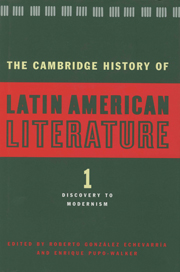Book contents
- Frontmatter
- Introduction to Volume 1
- 1 A brief history of the history of Spanish American Literature
- 2 Cultures in contact: Mesoamerica, the Andes, and the European written tradition
- 3 The first fifty years of Hispanic New World historiography: the Caribbean, Mexico, and Central America
- 4 Historians of the conquest and colonization of the New World: 1550–1620
- 5 Historians of the colonial period: 1620–1700
- 6 Colonial lyric
- 7 Epic poetry
- 8 Spanish American theatre of the colonial period
- 9 Viceregal culture
- 10 The eighteenth century: narrative forms, scholarship, and learning
- 11 Lyric poetry of the eighteenth and nineteenth centuries
- 12 Spanish American theatre of the eighteenth century
- 13 The nineteenth-century Spanish American novel
- 14 The brief narrative in Spanish America: 1835–1915
- 15 The Spanish American theatre of the nineteenth century
- 16 The essay in Spanish South America: 1800 to Modernismo
- 17 The essay of nineteenth-century Mexico, Central America, and the Caribbean
- 18 The gaucho genre
- Index
- Bibliographies
- References
5 - Historians of the colonial period: 1620–1700
Published online by Cambridge University Press: 28 March 2008
- Frontmatter
- Introduction to Volume 1
- 1 A brief history of the history of Spanish American Literature
- 2 Cultures in contact: Mesoamerica, the Andes, and the European written tradition
- 3 The first fifty years of Hispanic New World historiography: the Caribbean, Mexico, and Central America
- 4 Historians of the conquest and colonization of the New World: 1550–1620
- 5 Historians of the colonial period: 1620–1700
- 6 Colonial lyric
- 7 Epic poetry
- 8 Spanish American theatre of the colonial period
- 9 Viceregal culture
- 10 The eighteenth century: narrative forms, scholarship, and learning
- 11 Lyric poetry of the eighteenth and nineteenth centuries
- 12 Spanish American theatre of the eighteenth century
- 13 The nineteenth-century Spanish American novel
- 14 The brief narrative in Spanish America: 1835–1915
- 15 The Spanish American theatre of the nineteenth century
- 16 The essay in Spanish South America: 1800 to Modernismo
- 17 The essay of nineteenth-century Mexico, Central America, and the Caribbean
- 18 The gaucho genre
- Index
- Bibliographies
- References
Summary
Historiography of the seventeenth century reflected many of the patterns of historical writing developed during the earlier age of discovery and conquest. The principal historians of the sixteenth century worked with fundamental models of historical expression that survived well into the seventeenth and eighteenth centuries. We see a continuation of the crónica mayor, religious historiography that dealt with the history of religious orders and the spiritual life of the colony, various forms of testimonial literature, works that are primarily descriptive of New World geography, and other narrative modalities that were commonly employed during the era, such as the relación and learned commentaries. Yet there were significant developments within these well-defined norms – creative endeavors that have recently interested literary scholars – to communicate a more imaginative interpretation of those events and processes that led to the expansion and stabilization of the colonies. Though somewhat guided by functional models written in the sixteenth century, historical writing of the late colonial period became more complex and varied in style and structure.
Chroniclers of the Indies
A curious irony surrounds the role of cronista mayor during much of the seventeenth century. According to some indications, these historians were the most capable of any group of producing comprehensive studies of New World history. Those fulfilling this role had the greatest authority and prestige of any kind of historian in the late colonial period. They possessed the legal charge to petition, read, and censor the work of other historians writing about the American Conquest and settlement.
- Type
- Chapter
- Information
- The Cambridge History of Latin American Literature , pp. 143 - 190Publisher: Cambridge University PressPrint publication year: 1996
References
- 4
- Cited by



